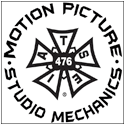 |
|
John Hancock on location in Michigan |
Veteran director John Hancock was in Chicago April 23 for the IFP/Facets screening of his horror movie “Suspended Animation.”
After 25 years as a Hollywood director, “Animation” is Hancock’s third film produced independently in his native LaPorte, Indiana. “Prancer” (1989) became a Christmas classic. Hancock’s company FilmAcres self-distributed “A Piece of Eden” (1999). “Animation” is due out in August from First Run Features.
Before the screening, Hancock regaled his audience with tales from his journey from the Midwest to Hollywood and back, working in and out of the studio system, and being fired as director of “Jaws 2.” Below are highlights from his talk.
On working in Indiana
Investors in LaPorte did it because they wanted to support the project for the town, and they believed in us. I had credibility from “Prancer,” and my parents had a farm there for 60 years. Everybody liked their peaches. Plus I was putting my own money into it, which was crucial.
It’s a wonderful place to do a movie. You get a lot for the money. It’s close to Chicago, so we can work with Chicago technicians and equipment, but it’s outside the union jurisdiction. We were SAG and DGA, but not IATSE.
We had tremendous cooperation from the community. We had 1,200 extras turn out for “Eden,” for no pay. We gave them each a bag of apples, and they still came back the second day.
It’s an area where people are hungry to have a movie made. The owner of the house we shot at in Malibu for “Animation” was in the habit of renting the house for $25,000 a day to Hollywood productions. In LaPorte, they’ll let you use the house for free, and they’ll go stay at a hotel at their own expense.
For “Eden” we found a guy who built remote controlled furnaces. He built us ten remote controlled sheep, with articulated legs, using rotisserie motors, to go off a cliff.
On “Prancer” we spent $150,000 for a Hollywood special effects guy to make a hydraulic reindeer head that was operated by six puppeteers. But when we got in the editing room we found that it was unusable. But for $500 we ended up with ten sheep.
On firing “Animation’s” lead actor (twice)
First we had Richard Grieco (“21 Jump Street”), who I thought was at least a mini-name. He came to rehearse, and I couldn’t bear to watch him. It was a pay-or-play deal, so we paid him his $50,000 and sent him on his way.
Then I cast Richard Edson (“Stranger than Paradise”), who is a thrilling actor in tiny parts, just super. He warned me “I’m not a trained actor.” We started to rehearse, and I understood what he meant. He didn’t know how to be afraid. He’d been getting by on a wonderful natural quality, but he had no internal technique. I dreaded going to rehearsal, he was so boring.
We started to shoot without a male lead. We flew to L.A. on the first weekend of the shoot, and brought back Alex MacArthur (“Kiss the Girls”)to play the role.
On the pros and cons of name actors
When we screened “Animation” for distributors, we got the reaction: “It doesn’t have any names. I like it, but I don’t know how to sell it.”
How can you sell it? It’s scary.
Next time, it’s important to have a name. But it’s nightmarishly difficult to get a name actor for a low budget film. The names you could afford are mini-second names. I thought those second names were the kiss of death, but next time I’ll kiss death.
With names you get into trailers and entourages. It ruins the low budget way of doing it. When one guy is pulling in so much, it’s hard to convince someone else to donate their time.
On casting
The key to directing is getting the right actor. It’s the sin of pride to think that you can take somebody and make their performance for them. I prefer to cast the right person, and give them almost no direction.
The main problem for most independent films is the acting. They cast their friends because they’re afraid of real actors.
On producers’ reps
On “A Piece of Eden,” we had no producer’s rep. Having been in the business for so long, I have access to heads of these companies. I thought, “why do we need a producer’s rep?” In retrospect, we might have been better off.
I made three independent films that were well distributed, so I thought I could get away with it, but maybe you can’t come in cold.
We got an L.A. attorney for “Animation.” We paid him a big fee, but it didn’t help much. We ended up selling to a guy I had known in New York for years.
Good producers’ reps won’t look at the picture without a name. John Sloss had “Animation” on his desk for three months without looking at it.
Reps said they would look at it, but they weren’t that interested because it had already screened, so it’s not virgin anymore and they don’t want to have sex with it.
On getting fired from “Jaws 2”
Universal executive Sid Sheinberg and producer Richard Zanuck blamed each other for overages on the first “Jaws.” I was Zanuck’s choice to direct “Jaws 2,” not Sheinberg’s. My wife Dorothy Tristan did the script.
Sheinberg’s wife, the actress Lorraine Gary, felt cheated that she couldn’t go out on the boat in the first picture. They had us over for dinner and she said, couldn’t she go out on the boat this time and save the children? Zanuck said ‘over my dead body.’ I sided with Zanuck. We turned in the next draft without Lorraine on the boat. Sheinberg never met my eyes again in the commissary.
Then I fired a girl in a small part who turned out to be the girlfriend of another Universal executive, and I replaced her with somebody who was not as good.
We started to shoot on Martha’s Vineyard. The shark wasn’t ready. It had never worked on the first picture, but they’d fudged it. They’d decide to perfect it with this one and have a whole elaborate new $2 million shark. Every time we tested it, it would break. It was clearly not shootable for several months.
So I had no Lorraine on the boat, I’d fired this guy’s girlfriend, and I had a shark that didn’t work. A Lear jet landed on the island and Sheinberg got off. The next day Dorothy and I were on a plane to Rome. Then I told the “National Enquirer” that the shark ate me. I was supposed to say “artistic differences.”
John Hancock is at FilmAcres, 219/326-9331, 352 N. Fail Road, LaPorte, Indiana, or www.suspended-animation.com.
–Ed M. Koziarski, edk@homesickblues.com

















